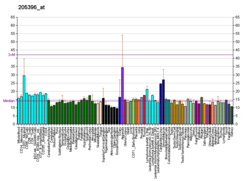| SMAD3 |
|---|
 |
|
| Structures disponibles |
|---|
| PDB | Recherche d'orthologue: PDBe RCSB |
|---|
| Identifiants PDB |
|---|
2LB2, 1MHD, 1MJS, 1MK2, 1OZJ, 1U7F, 2LAJ, 5OD6, 5ODG |
|
|
| Identifiants |
|---|
| Aliases | SMAD3 |
|---|
| IDs externes | OMIM: 603109 MGI: 1201674 HomoloGene: 55937 GeneCards: SMAD3 |
|---|
| Position du gène (Homme) |
|---|
 | | Chr. | Chromosome 15 humain[1] |
|---|
| | Locus | 15q22.33 | Début | 67,063,763 bp[1] |
|---|
| Fin | 67,195,173 bp[1] |
|---|
|
| Position du gène (Souris) |
|---|
 | | Chr. | Chromosome 9 (souris)[2] |
|---|
| | Locus | 9|9 C | Début | 63,554,049 bp[2] |
|---|
| Fin | 63,665,276 bp[2] |
|---|
|
| Expression génétique |
|---|
| Bgee | | Humain | Souris (orthologue) |
|---|
| Fortement exprimé dans | - tendon of biceps brachii
- cartilage tissue
- muscle de la cuisse
- mucosa of esophagus
- epithelium of colon
- muscle gastrocnémien
- jointure synoviale
- Skeletal muscle tissue of biceps brachii
- mucosa of urinary bladder
- olfactory zone of nasal mucosa
|
| | Fortement exprimé dans | - tubercule génital
- muscle temporal
- muscle triceps brachial
- molaire
- cheville
- muscle sterno-cléido-mastoïdien
- tail of embryo
- artère carotide interne
- artère carotide externe
- fosse
|
| | Plus de données d'expression de référence |
|
|---|
| BioGPS | 

 | | Plus de données d'expression de référence |
|
|---|
|
|
| Orthologues |
|---|
| Espèces | Homme | Souris |
|---|
| Entrez | | |
|---|
| Ensembl | | |
|---|
| UniProt | | |
|---|
| RefSeq (mRNA) | |
|---|
NM_001145102
NM_001145103
NM_001145104
NM_005902 |
| |
|---|
| RefSeq (protéine) | |
|---|
NP_001138574
NP_001138575
NP_001138576
NP_005893 |
| |
|---|
| Localisation (UCSC) | Chr 15: 67.06 – 67.2 Mb | Chr 9: 63.55 – 63.67 Mb |
|---|
| Publication PubMed | [3] | [4] |
|---|
|
| Wikidata |
| Voir/Editer Humain | Voir/Editer Souris |
|

 Portail de la biologie cellulaire et moléculaire
Portail de la biologie cellulaire et moléculaire  Portail de la médecine
Portail de la médecine 





















